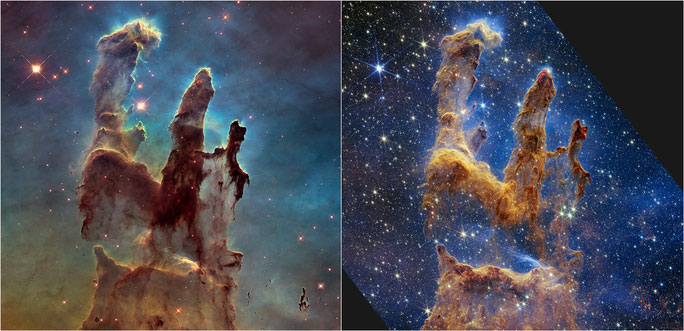NASA has just unveiled stunning images capturing what are known as the pillars of creation, where new worlds are literally being born.
The photos were taken by the James Webb Space Telescope, primarily operated by NASA, with support from the European Space Agency (ESA) and the Canadian Space Agency (CSA).
In the images, a colossal, eerie nebula appears like a divine hand reaching straight up into the sky, with fingers as robust as towering pillars. This is the Eagle Nebula, a magnificent star-forming region located in the constellation Serpens.

Latest image from James Webb – (Photo: NASA/ ESA/ CSA/ STScI)
“I have been studying the Eagle Nebula since the mid-1990s, trying to see ‘inside’ the light-years-long pillars that Hubble showed, searching for young stars within them. I always knew that when James Webb captured it, the images would be spectacular,” said Professor Mark McCaughrean, a senior science advisor at ESA, according to the BBC.
According to NASA, the most prominent feature in the images from the Near Infrared Camera (NIRCam) of James Webb is the newly forming stars, still in the “pre-stellar” phase, glowing bright red and located outside one of the pillars made of gas and dust.

Two distinctly different images captured by the Hubble Space Telescope (left) and James Webb – (Photo: NASA/ESA/CSA/STScI)
When these bright red spheres gain sufficient mass within the clouds of gas and dust, they begin to collapse under their own gravity, gradually heating up and becoming true protostars. As these new worlds grow, they will eventually form planets orbiting around them, where it is very likely that alien life could arise and thrive for billions of years to come.
The wavy patterns resembling lava at the edges of some pillars are powerful energy and material ejections from these young stars, which are periodically shooting out supersonic jets that collide with surrounding material clouds, creating a stunning spectacle. These young stars are only a few hundred thousand years old.
Observing these newly “wobbly” born worlds provides excellent data for scientists to understand how stars and planets form, thereby unlocking some of the age-old mysteries of how we exist in the universe.


















































